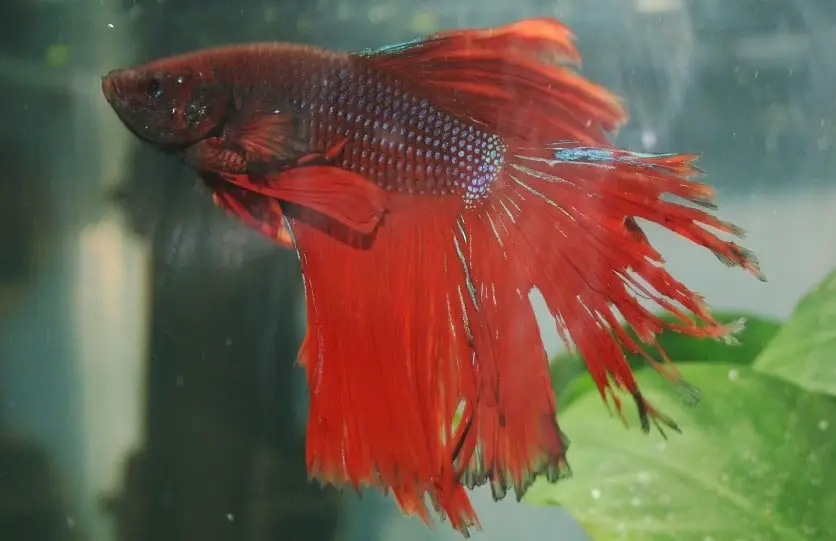Betta fish fin rot is a common and frustrating infection that can affect your betta fish. More specifically, it is a bacterial infection that causes the betta’s fins to deteriorate.
The good news is there are ways you can treat fin rot in your fish and prevent it from coming back. In this blog post, we’ll go over all of the symptoms, causes, and treatments for betta fin rot!
Why Does My Betta Have Fin Rot?
The most common reason for betta fish fin rot is poor water quality. When the water is dirty or stagnant, it can create an environment where bacteria and fungus thrive. These organisms can cause serious damage to your betta’s fins, leading to fin rot.
Injury to the fins can also lead to fin rot. Betta fish are notorious for their aggressive behavior, and they often attack each other’s fins. This can cause the fins to become damaged and susceptible to infection.
Poor nutrition is another common cause of fin rot. If your betta isn’t getting enough of the right nutrients, its fins may start to deteriorate. This is because your betta will have a weak immune system that isn’t able to fight off the infection.
How to Treat Betta Fish Fin Rot?
If you suspect that your betta fish has fin rot, there are a few things you can do to help him/her get better. The earlier you discover the fin rot, the easier it will be to treat.
The first thing you should consider doing is moving your betta to a quarantine tank. This will stop the infection from spreading to other fish, prevent your betta from getting worse, and protect your plants from any treatment you use.
If the fin rot is mild, you may be able to treat it with a salt bath. Add one tablespoon of aquarium salt per gallon of water and let your betta soak for about fifteen minutes. Be sure to change the water regularly, as the salt can be harmful to plants and other fish.
Aquarium Salt For Betta Fin Rot
Salt is often used as a treatment for betta fish fin rot. When added to the water, it creates an environment that is hostile to bacteria and fungus. This can help stop the infection from spreading and promote healing.
You can buy aquarium salt at most pet stores or online. Just be sure to get marine salt, not table salt, which will not have the same effect. Also, only use the salt for a maximum of 10 days!
Bettafix & Melafix for Betta Fin Rot
Another common treatment is Bettafix or Melafix, both of which are available from Amazon.
Severe Fin Rot Treatment
If the fin rot is more severe, you’ll need to take more drastic measures. You will need to use medicine that is specifically designed for betta fish. Here’s a step-by-step guide to treating severe fin rot:
1) Quarantine your betta – Move your betta into a separate tank or clean water that is heated. It should also contain a bubbler to improve the oxygen levels of the quarantine tank.
2) Clean the main tank – Remove all of the water from the main tank and clean it thoroughly. If you have gravel, remove that too and wash in hot water with a bit of antibacterial soap to kill any remaining bacteria/fungus.
Rinse out the filter media before placing them back into the tank because they may also be contaminated with harmful organisms!
3. Treat your betta with antibiotics – Pour some antibiotics into the quarantine tank (carefully follow the instructions on the bottle). I recommend the following antibiotics for treating betta fish fin rot: API Fungus Cure, and API Furan-2.
4) Return your betta to its home – After a few days, return your betta to its home. You should maintain a clean tank to stop it from happening again. Remember, your betta will likely be stressed during this period, so keep the water quality high and keep him in a calm environment.

How to Prevent Betta Fish Fin Rot?
The best way to prevent betta fish fin rot is to maintain the water quality in your tank. Make sure to change the water regularly and use a filter to keep the water clean.
Here are my top tips for maintaining high water quality:
- A temperature of at least 78°F (see here)
- Clearwater that isn’t cloudy
- You can’t see poop floating around in the tank
- Ammonia and nitrite levels are at 0ppm
- Nitrate levels are at 20ppm
Preventing Injury
To prevent injury to the fins, you can try to create a more peaceful environment for your bettas. Make sure they have plenty of places to hide and avoid putting too many fish in one tank. Moss balls provide a great place for bettas to hide and can help reduce stress.
Providing a Balanced Diet
Make sure your betta is getting a balanced diet that includes protein, carbohydrates, and healthy fats. This will keep your betta healthy and help it to fight off any infection that could lead to fin rot.
You can also add a betta supplement to their diet to ensure they’re getting all the nutrients they need.
Betta Fish Fin Rot Symptoms
The most common symptom of betta fish fin rot is red or brown tattered fins. You may also notice your betta has developed ulcers on its body, which could be an indication that it’s suffering from a viral infection like herpes (more on this later).
If the problem isn’t caught early enough, you might see patches of white or gray fungus developing on the fins. If left untreated, fin rot can spread to other parts of your betta’s body and affect its swimming ability.
If you notice any symptoms of fin rot in your betta fish, it’s important that you take action right away! You may be able to prevent further damage by moving the fish into a quarantine tank and treating the water with a salt bath.
Is Betta Fish Fin Rot Contagious To Other Fish?
Yes, betta fish fin rot is contagious to other fish. If one of your bettas has fin rot, you need to keep them separated until it has completely healed. This will prevent the infection from spreading to any healthy fish in your tank that may not be able to fight it off.
How to Tell if Betta Is Recovering From Fin Rot?
If your betta is recovering from fin rot, you’ll start to see new tissue growth on the fins. The red or brown color will start to fade and the ulcers will begin to heal. If the infection was severe, it may take a while for the fins to grow back completely.
Keep an eye on your betta during the healing process and make sure the water quality in the tank is still high. With time and patience, your betta fish will start to look and feel like its old self again!
Conclusion
In conclusion, betta fish fin rot is a common problem that can be caused by a variety of things. The most common cause is poor water quality, but it can also be caused by a lack of nutrients or an injury to the fins.
The best way to prevent betta fish fin rot is to maintain high water quality and make sure your betta is getting a healthy diet. If your betta does develop fin rot, you can try to treat it with aquarium salt or other supplements like Bettafix & Melafix.
The sooner you catch the infection and get started on treatment, the better chance of recovery your betta will have!
I hope this blog post helps you prevent betta fish fin rot in the future! If you have any questions, feel free to reach out with a message.






